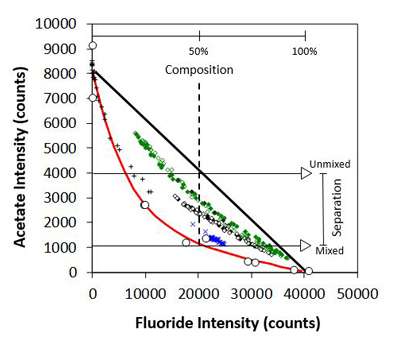Researchers examine the matrix effect in secondary ion mass spectrometry

Mass spectrometry images provide a wonderful means of visualising molecules with high sensitivity, excellent specificity and in a label-free manner. They are rich in information and useful as a guide to the location of molecules in a sample.
However, their seductive power and beauty can lead weak minds astray. The most common pitfall is to believe that an increased intensity in an image can be interpreted as an increase in concentration of the molecule in the sample. More often than not this is true, occasionally it is decidedly false. The culprit is the shady and impish paramour of surface mass spectrometry: the notorious and badly understood 'matrix effect'.
To investigate this effect, NPL has generated mixed reference materials of well-known composition and studied them using SIMS. Some of the ions, such as the fluoride ions shown in the figure, have an intensity proportional to the composition. Others are not, such as the acetate ions in the figure which arise from the second component in the mixture. NPL's work, published as an invited paper in a special issue of the International Journal of Mass Spectrometry entitled 'MS 1960 to Now' is the first serious investigation of the matrix effect in organic secondary ion mass spectrometry.
This work will lead to a greater understanding of how to extract reliable compositional data from imaging mass spectrometry, as well as understanding how the infamous matrix effect may be turned to some use. This apparently shifty character is not actually evil, just in need of some attention and understanding. For example, the researchers point out that different ions display different matrix effects and this could be used to identify nanoscale phase separation of materials in secondary ion mass spectrometry. This is demonstrated in the figure, which shows how the data from a depth profile provides information on both a 'composition' and a 'separation' scalebar.
More information: "The matrix effect in organic secondary ion mass spectrometry," International Journal of Mass Spectrometry, Volume 377, 1 February 2015, Pages 599-609, ISSN 1387-3806, dx.doi.org/10.1016/j.ijms.2014.06.027
Provided by National Physical Laboratory




















